Association of Microbiome Diversity with Disease Symptoms in Brassica oleracea Leaves
Abstract
:1. Introduction
2. Materials and Methods
2.1. Plant Material
2.2. DNA Extraction, Library Preparation, and Metagenomic Sequencing
2.3. Sequencing Data Processing and Metagenome Assembly
2.4. Gene Prediction and Taxonomic Annotation
3. Results
3.1. Data Pre-Processing and Metagenome Assembly
3.2. Microbial Communities in B. oleracea Leaves under Natural Infection Conditions
3.3. Bacterial Community in B. oleracea Leaves under Natural Infection Conditions
3.4. Fungal Community in B. oleracea Leaves under Natural Infection Conditions
3.5. Common and Specific Microorganisms in B. oleracea Leaves under Natural Infection Conditions
3.6. Functional Analysis of B. oleracea Metagenomes
4. Discussion
5. Conclusions
Supplementary Materials
Author Contributions
Funding
Institutional Review Board Statement
Informed Consent Statement
Data Availability Statement
Acknowledgments
Conflicts of Interest
References
- OECD. Brassica Crops (Brassica Species). In Safety Assessment of Transgenic Organisms; OECD: Paris, France, 2016; Volume 5. [Google Scholar]
- Greer, S.F.; Surendran, A.; Grant, M.; Lillywhite, R. The Current Status, Challenges, and Future Perspectives for Managing Diseases of Brassicas. Front. Microbiol. 2023, 14, 1209258. [Google Scholar] [CrossRef] [PubMed]
- Siciliano, I.; Gilardi, G.; Ortu, G.; Gisi, U.; Gullino, M.L.; Garibaldi, A. Identification and Characterization of Alternaria Species Causing Leaf Spot on Cabbage, Cauliflower, Wild and Cultivated Rocket by Using Molecular and Morphological Features and Mycotoxin Production. Eur. J. Plant Pathol. 2017, 149, 401–413. [Google Scholar] [CrossRef]
- Vicente, J.G.; Holub, E.B. Xanthomonas Campestris Pv. Campestris (Cause of Black Rot of Crucifers) in the Genomic Era Is Still a Worldwide Threat to Brassica Crops. Mol. Plant Pathol. 2013, 14, 2–18. [Google Scholar] [CrossRef]
- Lv, H.; Miyaji, N.; Osabe, K.; Akter, A.; Mehraj, H.; Shea, D.J.; Fujimoto, R. The Importance of Genetic and Epigenetic Research in the Brassica Vegetables in the Face of Climate Change. In Genomic Designing of Climate-Smart Vegetable Crops; Springer International Publishing: Berlin/Heidelberg, Germany, 2020; pp. 161–255. ISBN 9783319974156. [Google Scholar]
- Lv, H.; Fang, Z.; Yang, L.; Zhang, Y.; Wang, Y. An Update on the Arsenal: Mining Resistance Genes for Disease Management of Brassica Crops in the Genomic Era. Hortic. Res. 2020, 7, 1–18. [Google Scholar] [CrossRef]
- Mendes, R.; Garbeva, P.; Raaijmakers, J.M. The Rhizosphere Microbiome: Significance of Plant Beneficial, Plant Pathogenic, and Human Pathogenic Microorganisms. FEMS Microbiol. Rev. 2013, 37, 634–663. [Google Scholar] [CrossRef] [PubMed]
- Vogel, C.M.; Potthoff, D.B.; Schäfer, M.; Barandun, N.; Vorholt, J.A. Protective Role of the Arabidopsis Leaf Microbiota against a Bacterial Pathogen. Nat. Microbiol. 2021, 6, 1537–1548. [Google Scholar] [CrossRef] [PubMed]
- Lemanceau, P.; Blouin, M.; Muller, D.; Moënne-Loccoz, Y. Let the Core Microbiota Be Functional. Trends Plant Sci. 2017, 22, 583–595. [Google Scholar] [CrossRef]
- Ali, S.; Tyagi, A.; Bae, H.; Ali, S.; Tyagi, A.; Bae, H. Plant Microbiome: An Ocean of Possibilities for Improving Disease Resistance in Plants. Microorganisms 2023, 11, 392. [Google Scholar] [CrossRef]
- Berihu, M.; Somera, T.S.; Malik, A.; Medina, S.; Piombo, E.; Tal, O.; Cohen, M.; Ginatt, A.; Ofek-Lalzar, M.; Doron-Faigenboim, A.; et al. A Framework for the Targeted Recruitment of Crop-Beneficial Soil Taxa Based on Network Analysis of Metagenomics Data. Microbiome 2023, 11, 8. [Google Scholar] [CrossRef]
- Compant, S.; Samad, A.; Faist, H.; Sessitsch, A. A Review on the Plant Microbiome: Ecology, Functions, and Emerging Trends in Microbial Application. J. Adv. Res. 2019, 19, 29–37. [Google Scholar] [CrossRef]
- Bechtold, E.K.; Ryan, S.; Moughan, S.E.; Ranjan, R.; Nüsslein, K. Phyllosphere Community Assembly and Response to Drought Stress on Common Tropical and Temperate Forage Grasses. Appl. Environ. Microbiol. 2021, 87, e00895-21. [Google Scholar] [CrossRef] [PubMed]
- Chen, Y.; Yao, Z.; Sun, Y.; Wang, E.; Tian, C.; Sun, Y.; Liu, J.; Sun, C.; Tian, L. Current Studies of the Effects of Drought Stress on Root Exudates and Rhizosphere Microbiomes of Crop Plant Species. Int. J. Mol. Sci. 2022, 23, 2374. [Google Scholar] [CrossRef] [PubMed]
- Suman, A.; Govindasamy, V.; Ramakrishnan, B.; Aswini, K.; SaiPrasad, J.; Sharma, P.; Pathak, D.; Annapurna, K. Microbial Community and Function-Based Synthetic Bioinoculants: A Perspective for Sustainable Agriculture. Front. Microbiol. 2022, 12, 805498. [Google Scholar] [CrossRef] [PubMed]
- Levy, A.; Salas Gonzalez, I.; Mittelviefhaus, M.; Clingenpeel, S.; Herrera Paredes, S.; Miao, J.; Wang, K.; Devescovi, G.; Stillman, K.; Monteiro, F.; et al. Genomic Features of Bacterial Adaptation to Plants. Nat. Genet. 2017, 50, 138–150. [Google Scholar] [CrossRef] [PubMed]
- Regalado, J.; Lundberg, D.S.; Deusch, O.; Kersten, S.; Karasov, T.; Poersch, K.; Shirsekar, G.; Weigel, D. Combining Whole-Genome Shotgun Sequencing and RRNA Gene Amplicon Analyses to Improve Detection of Microbe–Microbe Interaction Networks in Plant Leaves. ISME J. 2020, 14, 2116–2130. [Google Scholar] [CrossRef] [PubMed]
- Bhargava, P.; Verma, A.; Singh, A.; Singh, S.; Vats, S.; Khan, M.; Goel, R. Metagenomics as a Tool to Explore New Insights from Plant-Microbe Interface. In Plant Microbe Interface; Springer International Publishing: Berlin/Heidelberg, Germany, 2019; pp. 271–289. ISBN 9783030198312. [Google Scholar]
- Nwachukwu, B.C.; Babalola, O.O. Metagenomics: A Tool for Exploring Key Microbiome With the Potentials for Improving Sustainable Agriculture. Front. Sustain. Food Syst. 2022, 6, 886987. [Google Scholar] [CrossRef]
- Mourou, M.; Raimondo, M.L.; Lops, F.; Carlucci, A. Brassicaceae Fungi and Chromista Diseases: Molecular Detection and Host–Plant Interaction. Plants 2023, 12, 1033. [Google Scholar] [CrossRef] [PubMed]
- Morales Moreira, Z.P.; Helgason, B.L.; Germida, J.J. Environment Has a Stronger Effect than Host Plant Genotype in Shaping Spring Brassica Napus Seed Microbiomes. Phytobiomes J. 2021, 5, 220–230. [Google Scholar] [CrossRef]
- Li, Y.; Vail, S.L.; Arcand, M.M.; Helgason, B.L. Contrasting Nitrogen Fertilization and Brassica Napus (Canola) Variety Development Impact Recruitment of the Root-Associated Microbiome. Phytobiomes J. 2023, 7, 125–137. [Google Scholar] [CrossRef]
- Etesami, H.; Alikhani, H.A. Rhizosphere and Endorhiza of Oilseed Rape (Brassica Napus L.) Plant Harbor Bacteria with Multifaceted Beneficial Effects. Biol. Control 2016, 94, 11–24. [Google Scholar] [CrossRef]
- Mamet, S.D.; Helgason, B.L.; Lamb, E.G.; McGillivray, A.; Stanley, K.G.; Robinson, S.J.; Aziz, S.U.; Vail, S.; Siciliano, S.D. Phenology-Dependent Root Bacteria Enhance Yield of Brassica Napus. Soil Biol. Biochem. 2022, 166, 108468. [Google Scholar] [CrossRef]
- Zhang, Q.; Zhang, J.; Yang, L.; Zhang, L.; Jiang, D.; Chen, W.; Li, G. Diversity and Biocontrol Potential of Endophytic Fungi in Brassica Napus. Biol. Control 2014, 72, 98–108. [Google Scholar] [CrossRef]
- Rybakova, D.; Mancinelli, R.; Wikström, M.; Birch-Jensen, A.S.; Postma, J.; Ehlers, R.U.; Goertz, S.; Berg, G. The Structure of the Brassica Napus Seed Microbiome Is Cultivar-Dependent and Affects the Interactions of Symbionts and Pathogens. Microbiome 2017, 5, 104. [Google Scholar] [CrossRef] [PubMed]
- Links, M.G.; Demeke, T.; Gräfenhan, T.; Hill, J.E.; Hemmingsen, S.M.; Dumonceaux, T.J. Simultaneous Profiling of Seed-Associated Bacteria and Fungi Reveals Antagonistic Interactions between Microorganisms within a Shared Epiphytic Microbiome on Triticum and Brassica Seeds. New Phytol. 2014, 202, 542–553. [Google Scholar] [CrossRef]
- Wassermann, B.; Abdelfattah, A.; Wicaksono, W.A.; Kusstatscher, P.; Müller, H.; Cernava, T.; Goertz, S.; Rietz, S.; Abbadi, A.; Berg, G. The Brassica Napus Seed Microbiota Is Cultivar-Specific and Transmitted via Paternal Breeding Lines. Microb. Biotechnol. 2022, 15, 2379–2390. [Google Scholar] [CrossRef]
- Yao, Y.; Liu, C.; Zhang, Y.; Lin, Y.; Chen, T.; Xie, J.; Chang, H.; Fu, Y.; Cheng, J.; Li, B.; et al. The Dynamic Changes of Brassica Napus Seed Microbiota across the Entire Seed Life in the Field. Plants 2024, 13, 912. [Google Scholar] [CrossRef] [PubMed]
- Lebreton, L.; Guillerm-Erckelboudt, A.Y.; Gazengel, K.; Linglin, J.; Ourry, M.; Glory, P.; Sarniguet, A.; Daval, S.; Manzanares-Dauleux, M.J.; Mougel, C. Temporal Dynamics of Bacterial and Fungal Communities during the Infection of Brassica Rapa Roots by the Protist Plasmodiophora Brassicae. PLoS ONE 2019, 14, e0204195. [Google Scholar] [CrossRef] [PubMed]
- Chen, J.; Akutse, K.S.; Saqib, H.S.A.; Wu, X.; Yang, F.; Xia, X.; Wang, L.; Goettel, M.S.; You, M.; Gurr, G.M. Fungal Endophyte Communities of Crucifer Crops Are Seasonally Dynamic and Structured by Plant Identity, Plant Tissue and Environmental Factors. Front. Microbiol. 2020, 11, 528766. [Google Scholar] [CrossRef]
- Poveda, J.; Díaz-González, S.; Díaz-Urbano, M.; Velasco, P.; Sacristán, S. Fungal Endophytes of Brassicaceae: Molecular Interactions and Crop Benefits. Front. Plant Sci. 2022, 13, 932288. [Google Scholar] [CrossRef]
- Wassermann, B.; Rybakova, D.; Müller, C.; Berg, G. Harnessing the Microbiomes of Brassica Vegetables for Health Issues. Sci. Rep. 2017, 7, 17649. [Google Scholar] [CrossRef]
- Escolà, G.; González-Miguel, V.M.; Campo, S.; Catala-Forner, M.; Domingo, C.; Marqués, L.; San Segundo, B. Development and Genome-Wide Analysis of a Blast-Resistant Japonica Rice Variety. Plants 2023, 12, 3536. [Google Scholar] [CrossRef] [PubMed]
- McMurdie, P.J.; Holmes, S. Phyloseq: An R Package for Reproducible Interactive Analysis and Graphics of Microbiome Census Data. PLoS ONE 2013, 8, e61217. [Google Scholar] [CrossRef] [PubMed]
- Huson, D.H.; Mitra, S.; Ruscheweyh, H.J.; Weber, N.; Schuster, S.C. Integrative Analysis of Environmental Sequences Using MEGAN4. Genome Res. 2011, 21, 1552–1560. [Google Scholar] [CrossRef] [PubMed]
- Ondov, B.D.; Bergman, N.H.; Phillippy, A.M. Interactive Metagenomic Visualization in a Web Browser. BMC Bioinform. 2011, 12, 385. [Google Scholar] [CrossRef] [PubMed]
- Cantarel, B.I.; Coutinho, P.M.; Rancurel, C.; Bernard, T.; Lombard, V.; Henrissat, B. The Carbohydrate-Active EnZymes Database (CAZy): An Expert Resource for Glycogenomics. Nucleic Acids Res. 2009, 37, D233–D238. [Google Scholar] [CrossRef] [PubMed]
- Kameshwar, A.K.S.; Ramos, L.P.; Qin, W. CAZymes-Based Ranking of Fungi (CBRF): An Interactive Web Database for Identifying Fungi with Extrinsic Plant Biomass Degrading Abilities. Bioresour. Bioprocess. 2019, 6, 51. [Google Scholar] [CrossRef]
- Rafiei, V.; Vélëz, H.; Tzelepis, G. The Role of Glycoside Hydrolases in Phytopathogenic Fungi and Oomycetes Virulence. Int. J. Mol. Sci. 2021, 22, 9359. [Google Scholar] [CrossRef] [PubMed]
- Lombard, V.; Golaconda Ramulu, H.; Drula, E.; Coutinho, P.M.; Henrissat, B. The Carbohydrate-Active Enzymes Database (CAZy) in 2013. Nucleic Acids Res. 2014, 42, D490–D495. [Google Scholar] [CrossRef] [PubMed]
- Francisco, M.; Tortosa, M.; Martínez-Ballesta, M.D.C.; Velasco, P.; García-Viguera, C.; Moreno, D.A. Nutritional and Phytochemical Value of Brassica Crops from the Agri-Food Perspective. Ann. Appl. Biol. 2017, 170, 273–285. [Google Scholar] [CrossRef]
- Rochefort, A.; Briand, M.; Marais, C.; Wagner, M.H.; Laperche, A.; Vallée, P.; Barret, M.; Sarniguet, A. Influence of Environment and Host Plant Genotype on the Structure and Diversity of the Brassica Napus Seed Microbiota Aude. Phytobiomes J. 2019, 3, 326–336. [Google Scholar] [CrossRef]
- An, S.Q.; Potnis, N.; Dow, M.; Vorhölter, F.J.; He, Y.Q.; Becker, A.; Teper, D.; Li, Y.; Wang, N.; Bleris, L.; et al. Mechanistic Insights into Host Adaptation, Virulence and Epidemiology of the Phytopathogen Xanthomonas. FEMS Microbiol. Rev. 2020, 44, 1–32. [Google Scholar] [CrossRef] [PubMed]
- Li, T.; Mann, R.; Sawbridge, T.; Kaur, J.; Auer, D.; Spangenberg, G. Novel Xanthomonas Species From the Perennial Ryegrass Seed Microbiome–Assessing the Bioprotection Activity of Non-Pathogenic Relatives of Pathogens. Front. Microbiol. 2020, 11, 553310. [Google Scholar] [CrossRef] [PubMed]
- Cabrefiga, J.; Bonaterra, A.; Montesinos, E. Mechanisms of Antagonism of Pseudomonas Fluorescens EPS62e against Erwinia Amylovora, the Causal Agent of Fire Blight. Int. Microbiol. 2007, 10, 123–132. [Google Scholar] [CrossRef] [PubMed]
- Khan, N.; Martínez-Hidalgo, P.; Ice, T.A.; Maymon, M.; Humm, E.A.; Nejat, N.; Sanders, E.R.; Kaplan, D.; Hirsch, A.M. Antifungal Activity of Bacillus Species Against Fusarium and Analysis of the Potential Mechanisms Used in Biocontrol. Front. Microbiol. 2018, 9, 401553. [Google Scholar] [CrossRef] [PubMed]
- Daulagala, P.W.H.K.P.; Allan, E.J. L-Form Bacteria of Pseudomonas Syringae Pv. Phaseolicola Induce Chitinases and Enhance Resistance to Botrytis Cinerea Infection in Chinese Cabbage. Physiol. Mol. Plant Pathol. 2003, 62, 253–263. [Google Scholar] [CrossRef]
- Bradley, E.L.; Ökmen, B.; Doehlemann, G.; Henrissat, B.; Bradshaw, R.E.; Mesarich, C.H. Secreted Glycoside Hydrolase Proteins as Effectors and Invasion Patterns of Plant-Associated Fungi and Oomycetes. Front. Plant Sci. 2022, 13, 853106. [Google Scholar] [CrossRef] [PubMed]
- Urquhart, E.J.; Punja, Z.K. Hydrolytic Enzymes and Antifungal Compounds Produced by Tilletiopsis Species, Phyllosphere Yeasts That Are Antagonists of Powdery Mildew Fungi. Can. J. Microbiol. 2002, 48, 219–229. [Google Scholar] [CrossRef] [PubMed]
- Kim, B.; Park, A.R.; Song, C.W.; Song, H.; Kim, J.C. Biological Control Efficacy and Action Mechanism of Klebsiella Pneumoniae JCK-2201 Producing Meso-2,3-Butanediol Against Tomato Bacterial Wilt. Front. Microbiol. 2022, 13, 914589. [Google Scholar] [CrossRef] [PubMed]
- Ji, S.H.; Gururani, M.A.; Chun, S.C. Isolation and Characterization of Plant Growth Promoting Endophytic Diazotrophic Bacteria from Korean Rice Cultivars. Microbiol. Res. 2014, 169, 83–98. [Google Scholar] [CrossRef]
- Walker, T.S.; Bais, H.P.; Déziel, E.; Schweizer, H.P.; Rahme, L.G.; Fall, R.; Vivanco, J.M. Pseudomonas Aeruginosa-Plant Root Interactions. Pathogenicity, Biofilm Formation, and Root Exudation. Plant Physiol. 2004, 134, 320–331. [Google Scholar] [CrossRef]
- Prithiviraj, B.; Bais, H.P.; Jha, A.K.; Vivanco, J.M. Staphylococcus Aureus Pathogenicity on Arabidopsis Thaliana Is Mediated Either by a Direct Effect of Salicylic Acid on the Pathogen or by SA-Dependent, NPR1-Independent Host Responses. Plant J. 2005, 42, 417–432. [Google Scholar] [CrossRef] [PubMed]

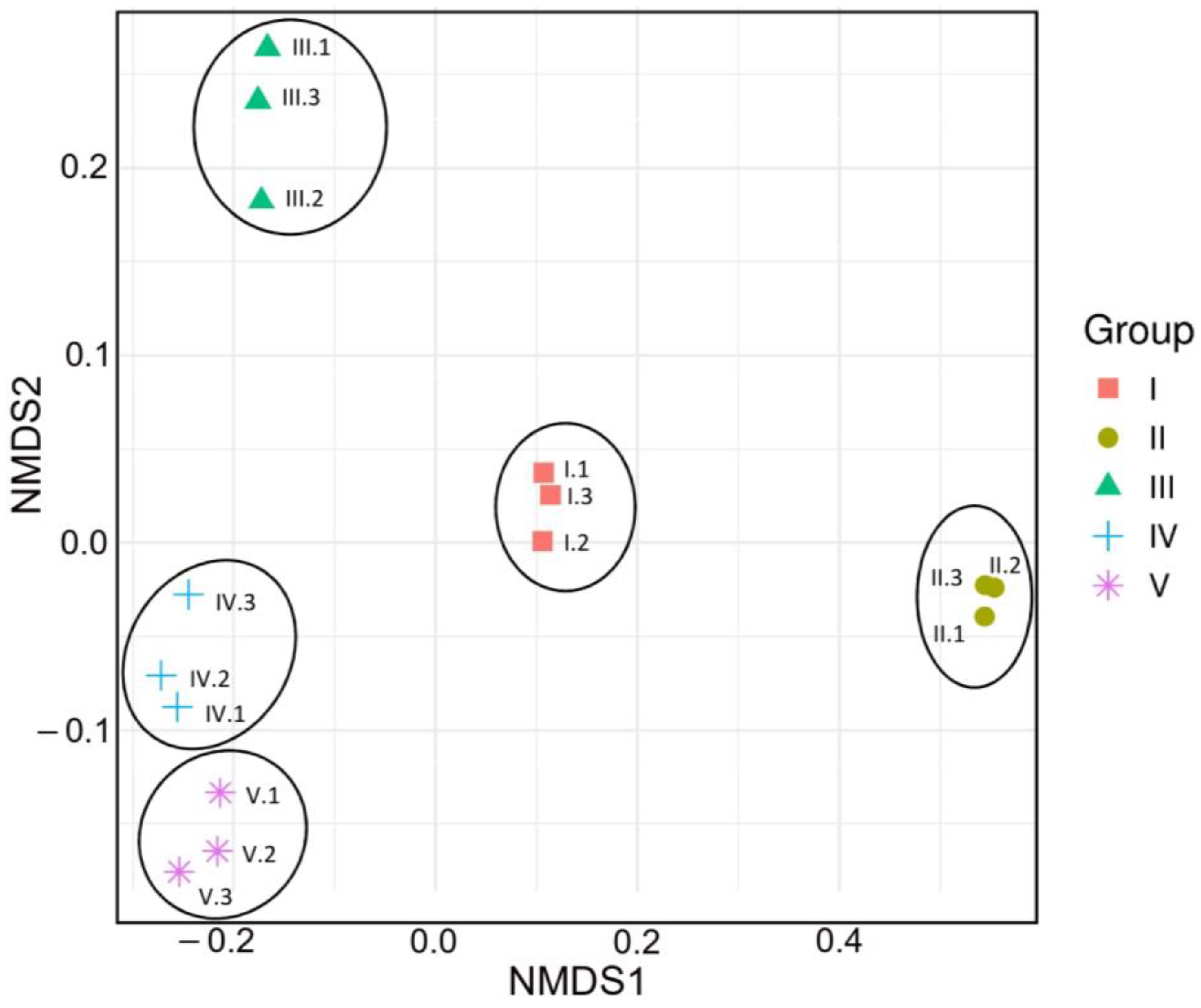
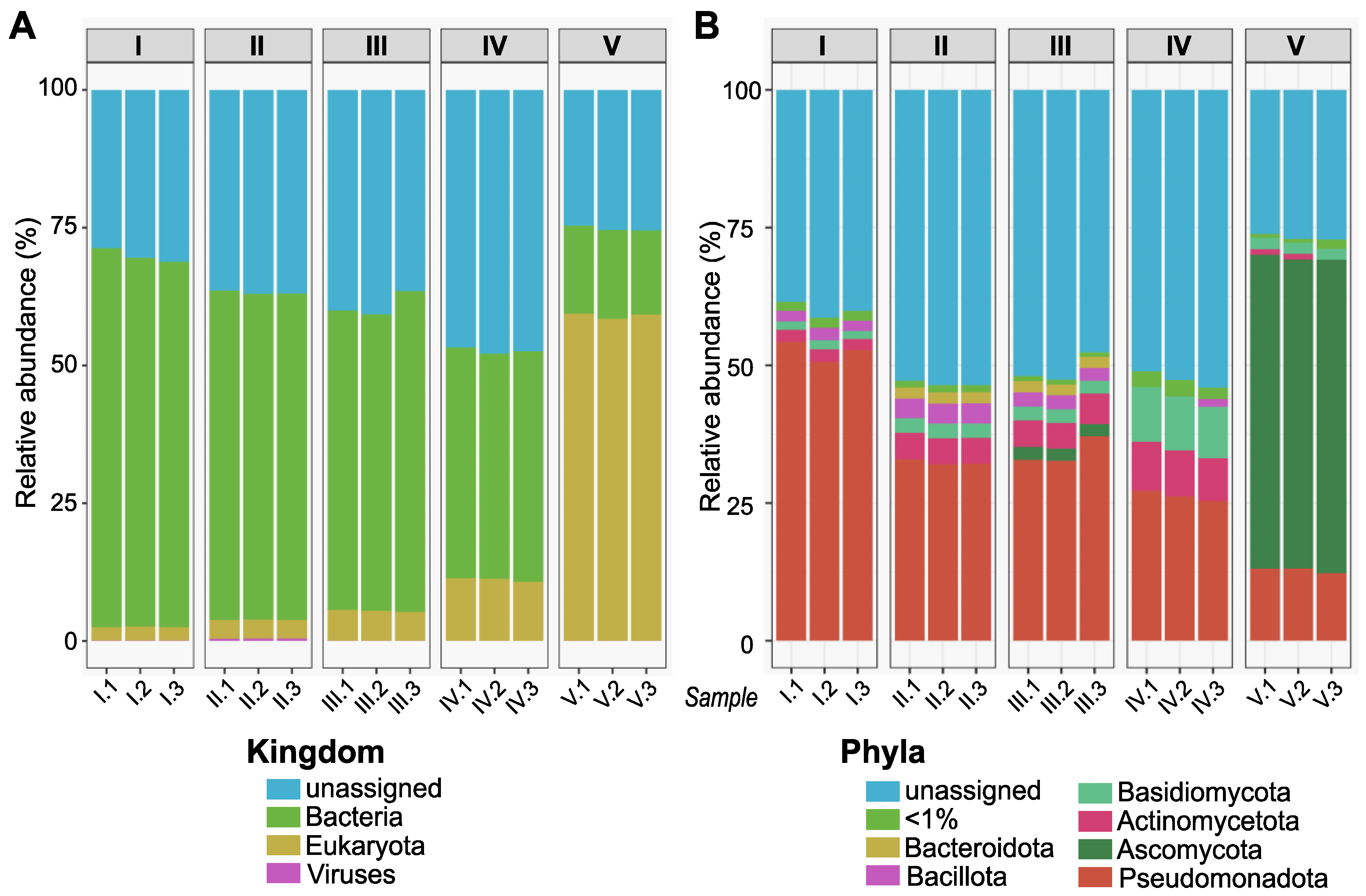
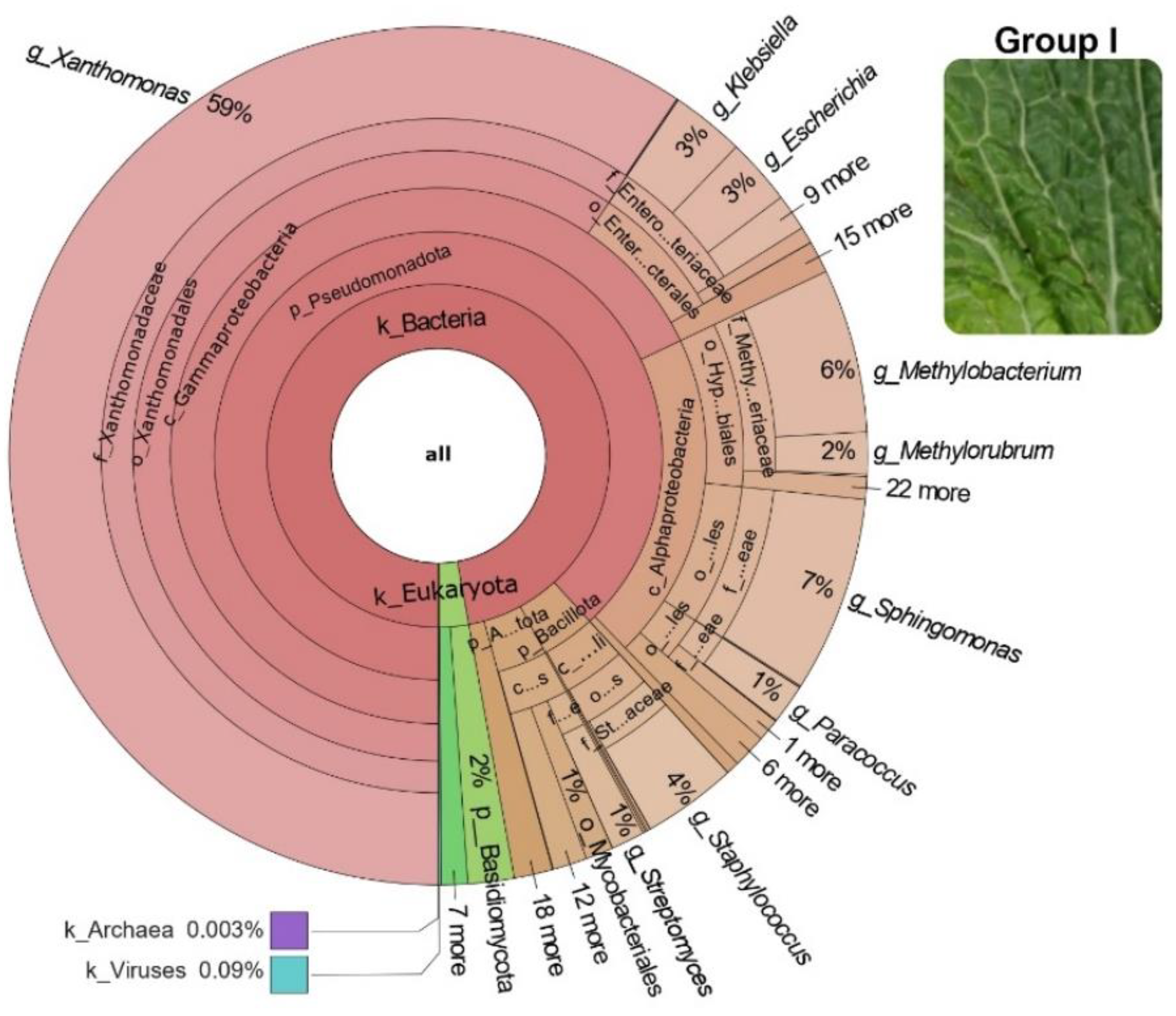
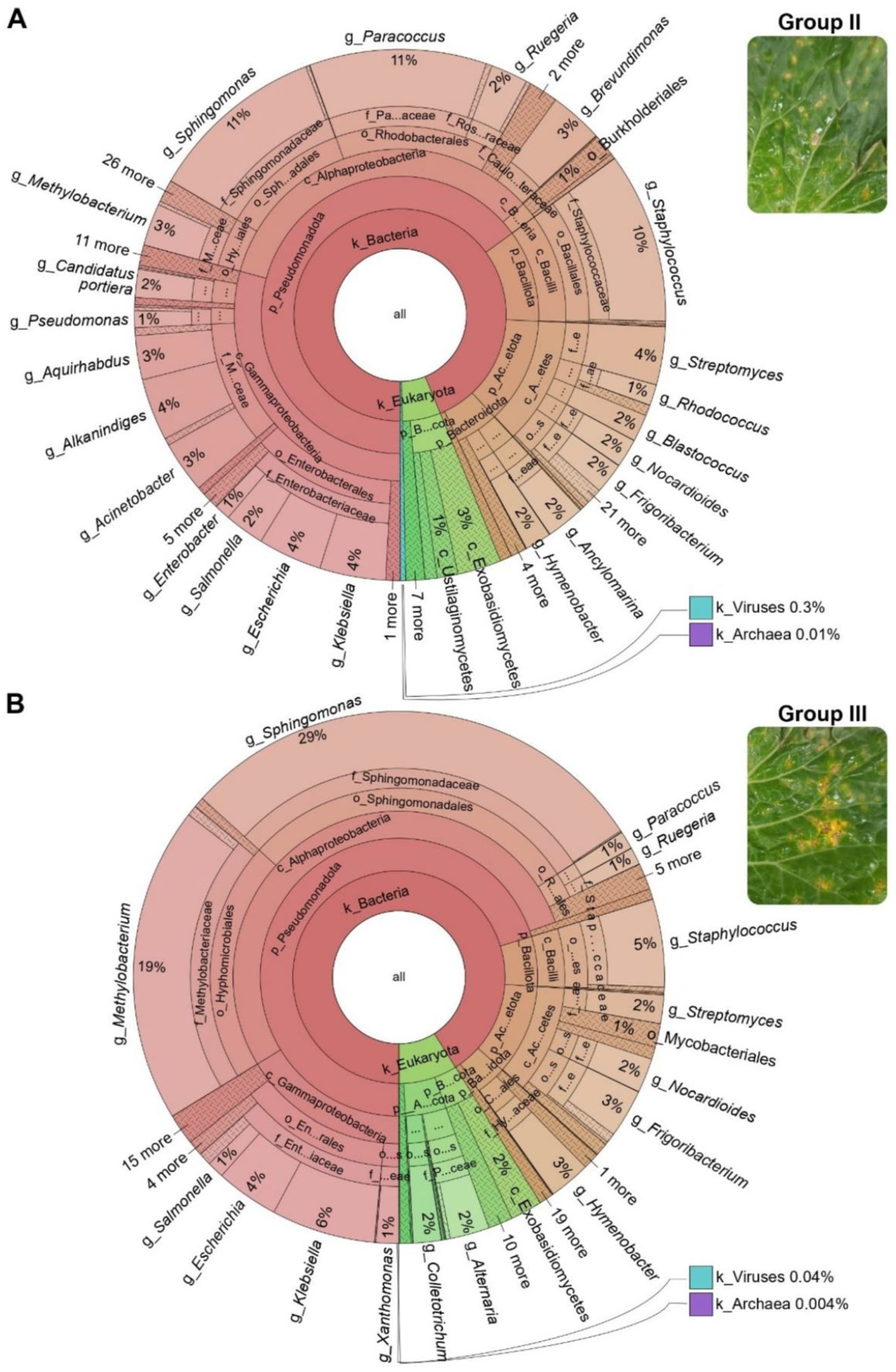



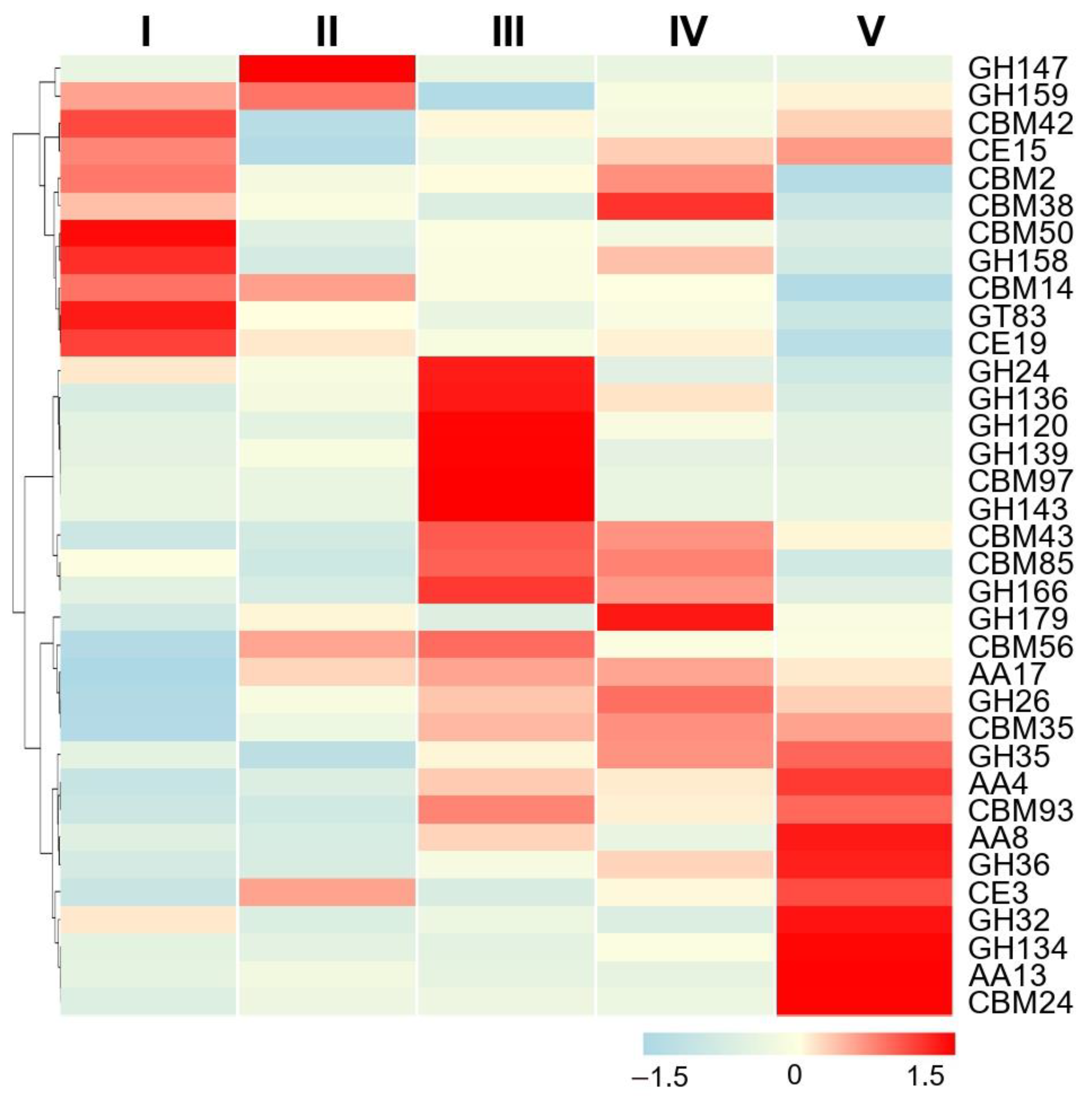
| Group | Kingdom | Phylum | Family | Genus | Species |
|---|---|---|---|---|---|
| I | Bacteria | Pseudomonadota | Xanthomonadaceae | Xanthomonas | X. arboricola |
| X. campestris | |||||
| X. hortorum | |||||
| X. nasturtii | |||||
| X. oryzae | |||||
| X. perforans | |||||
| X. phaseoli | |||||
| X. vesicatoria | |||||
| Methylobacteriaceae | Methylorubrum | M. aminovorans | |||
| M. extorquens | |||||
| M. populi | |||||
| M. rhodesianum | |||||
| M. rhodinum | |||||
| M. suomiense | |||||
| M. thiocyanatum | |||||
| M. zatmanii | |||||
| II | Bacteria | Pseudomonadota | Pseudomonadaceae | Pseudomonas | P. syringae |
| Burkholderiaceae | Paraburkholderia | P. aspalathi | |||
| P. ginsengiterrae | |||||
| Paracoccaceae | Paenirhodobacter | P. enshiensis | |||
| Rhodobaculum | R. claviforme | ||||
| Bacteria | Actinomycetota | Streptomycetaceae | Streptomyces | S. aureocirculatus | |
| S. canus | |||||
| S. gancidicus | |||||
| S. narbonensis | |||||
| III | Eukaryota | Ascomycota | Pleosporaceae | Alternaria | A. alternata |
| A. arborescens | |||||
| A. atra | |||||
| A. burnsii | |||||
| A. gaisen | |||||
| A. panax | |||||
| A. postmessia | |||||
| A. tenuissima | |||||
| A. ventricosa | |||||
| IV | Eukaryota | Basidiomycota | Ustilaginaceae | Pseudozyma | P. flocculosa |
| P. hubeiensis | |||||
| Ceratobasidiaceae | Rhizoctonia | R. solani | |||
| - | Tilletiopsis | T. washingtonensis | |||
| Tilletiariaceae | Tilletiaria | T. anomala | |||
| V | Eukaryota | Ascomycota | Sclerotiniaceae | Botryotinia | B. calthae |
| B. narcissicola | |||||
| B. convoluta | |||||
| B. globosa | |||||
| Botrytis | B. tulipae | ||||
| B. byssoidea | |||||
| B. cinerea | |||||
| B. elliptica | |||||
| B. fragariae | |||||
| B. galanthina | |||||
| B. hyacinthi | |||||
| B. paeoniae | |||||
| B. porri | |||||
| B. sinoallii | |||||
| Stromatinia | S. cepivora | ||||
| Sclerotinia | S. borealis | ||||
| S. sclerotiorum | |||||
| S. trifoliorum |
Disclaimer/Publisher’s Note: The statements, opinions and data contained in all publications are solely those of the individual author(s) and contributor(s) and not of MDPI and/or the editor(s). MDPI and/or the editor(s) disclaim responsibility for any injury to people or property resulting from any ideas, methods, instructions or products referred to in the content. |
© 2024 by the authors. Licensee MDPI, Basel, Switzerland. This article is an open access article distributed under the terms and conditions of the Creative Commons Attribution (CC BY) license (https://creativecommons.org/licenses/by/4.0/).
Share and Cite
Martín-Cardoso, H.; González-Miguel, V.M.; Soler-López, L.; Campo, S.; San Segundo, B. Association of Microbiome Diversity with Disease Symptoms in Brassica oleracea Leaves. Horticulturae 2024, 10, 765. https://doi.org/10.3390/horticulturae10070765
Martín-Cardoso H, González-Miguel VM, Soler-López L, Campo S, San Segundo B. Association of Microbiome Diversity with Disease Symptoms in Brassica oleracea Leaves. Horticulturae. 2024; 10(7):765. https://doi.org/10.3390/horticulturae10070765
Chicago/Turabian StyleMartín-Cardoso, Héctor, Víctor M. González-Miguel, Luis Soler-López, Sonia Campo, and Blanca San Segundo. 2024. "Association of Microbiome Diversity with Disease Symptoms in Brassica oleracea Leaves" Horticulturae 10, no. 7: 765. https://doi.org/10.3390/horticulturae10070765






